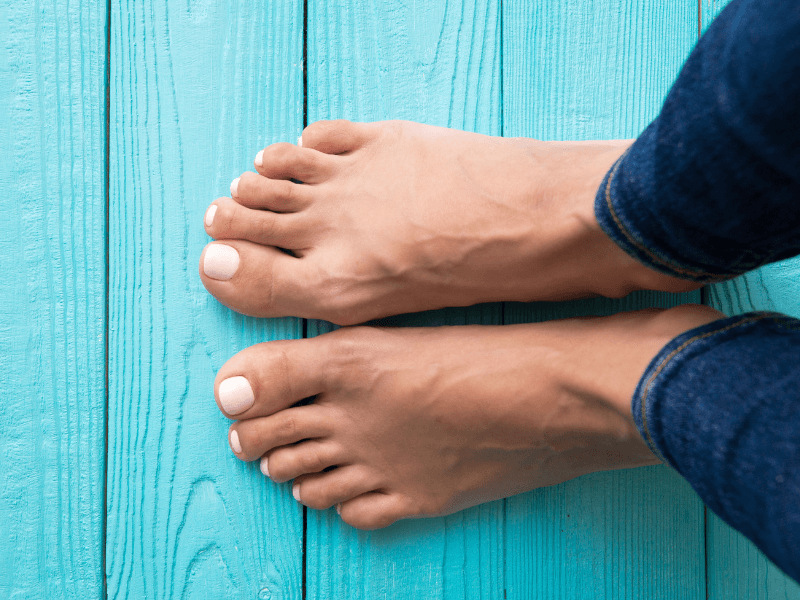Flat feet (also called Pes Planus) occur when the medial arch of the foot is lower than usual or absent when standing. Many people with flat feet have no pain and don’t need treatment, but for others the condition causes discomfort, tired feet, or problems further up the leg. This guide explains causes, clear signs that you should get professional help, self-help measures (useful exercises and footwear tips), and what to expect from orthotics and other treatments.
Quick facts
- Flat feet are common and often a normal variation of foot shape. Most cases don’t require treatment unless painful or progressive.
- Conservative care — exercises, supportive footwear, and orthoses — helps the majority of people. Surgery is reserved for severe or progressive cases.
What causes flat feet?
Common causes include:
- A naturally low/absent arch present from childhood (flexible flat feet).
- Age-related changes and wear of soft tissues — especially posterior tibial tendon dysfunction (PTTD) — which can cause acquired flatfoot in adults.
- Trauma, arthritis or neurological conditions in some cases.
Signs and symptoms to watch for
Flat feet are surprisingly common, with around 20% of UK adults having some degree of the condition. For most people, it’s an easy condition to live with. However, it can lead to some uncomfortable side effects such as:
- Foot pain, especially when walking long distances or standing for long periods of time
- Joint pain in the ankles and knees, and poor posture and backache due to the feet turning inwards
- Uneven wearing of the soles of your shoes
- Numbness or stiffness in your feet.
If you regularly suffer from any of these symptoms, seek medical advice from your GP or book an appointment with one of our registered podiatrists.
Self-help you can start today
1. Foot and calf stretches (do twice daily)
- Calf stretch (standing): Face a wall, place one foot behind the other and keep the back knee straight while leaning forward until you feel a stretch. Hold 30 seconds, repeat 3 times each side. Helpful for tight calves that contribute to pronation.
- Plantar fascia stretch: Cross one leg over the other, pull your toes towards the shin and hold 20–30 seconds. Repeat 3 times.
2. Strengthening exercises (short-foot and heel raises)
- Short-foot (arch draw-in): Sitting or standing, try to “shorten” the foot by pulling the ball of your foot toward the heel without curling your toes — hold 5–10 seconds, repeat 10 times per foot. Builds intrinsic foot muscle control. The guide from Aneurin Bevan University Health Board has more detail.
- Seated heel raises: Sit with feet flat, lift heels slowly and lower. Build to standing heel raises (calf raises) for progressive loading. 3 sets of 10–15 reps.
Tip: If you suspect posterior tibial tendon pain, begin with lower-load strengthening and follow guidance — eccentric loading programmes have shown benefit in PTTD. If pain increases significantly, reduce load and seek professional advice.
3. Activity modification
Reduce activities that flare symptoms (long runs, standing for long periods) while you build strength and change footwear/orthotics.
Footwear — what to choose
Good shoes can make a big difference:
- Look for firm heel counters (back of the shoe), good midfoot support and a stable sole.
- Avoid very flat, flimsy shoes or unsupportive slip-ons for daily wear.
- For sports, choose trainers with good arch support and stability features.
A podiatrist can advise which shoe features suit your foot and activity level. The Royal College of Podiatry has helpful guidance on everyday footwear and general footcare.
Orthotics and insoles — what helps, what to expect
- Over-the-counter (off-the-shelf) insoles: Can reduce symptoms for many people and are a cost-effective first step.
- Semi-bespoke or custom orthotics: Made from a cast or scan of your foot and prescribed by a podiatrist; often used when off-the-shelf options don’t help. Evidence supports orthoses for symptomatic pes planus to reduce pain and improve function.
- Bracing: For more severe or painful rigid deformities (or some PTTD cases) an ankle or foot brace may help.
Your podiatrist will explain realistic outcomes: orthotics often reduce pain and improve function, but they are not a permanent “cure” for everyone — they form part of a broader plan including exercises and footwear changes.
Children and flat feet
- Flat feet are very common in toddlers and young children because their arches are still developing. Most children develop a normal arch by age 6–10 and do not need any treatment.
- Seek assessment if a child has pain, tripping, frequent falls, stiffness, or a very asymmetric foot shape. Serious or rigid deformities and painful flat feet should be referred for specialist assessment. NHS paediatric orthopaedic guidance explains when referral is needed.
When is surgery considered?
In some cases, where the condition has been caused by a more serious underlying condition such as foot bone deformity, surgery may be the only way to resolve the problem. However, this is usually a last resort if the above non-surgical treatments have not fully resolved the problem.
Prevention and long-term living with flat feet
- Keep calf and foot muscles flexible and reasonably strong through regular stretching and short-foot work.
- Choose supportive shoes for long standing or walking.
- Maintain a healthy weight — excess body weight increases load through the arch and can worsen symptoms.
- Return-to-activity plans after pain settle should be gradual, and continue maintenance exercises.
At Feet by Pody’s London clinics, our podiatry service uses state-of-the-art biomechanical assessments to diagnose the root cause of your foot pain, identifying whether you may be suffering due to flat feet. We can advise strengthening foot exercises and provide you with bespoke orthotic insoles to help you with your day-to-day life.
For professional help to overcome flat feet, please call Feet By Pody today on 0207 099 6657 or book your appointment online.

